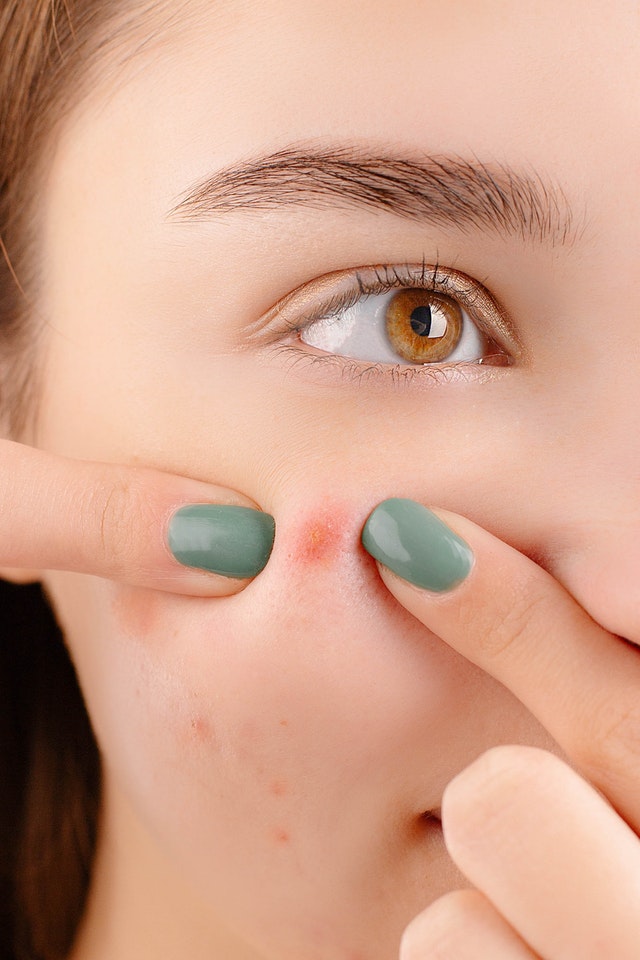Got a pesky pimple you want to pop? Dr. Zenovia, a board-certified dermatologist and hormonal acne expert is here to break down how to safely pop your pimples at home. Not all acne is the same. You may be prone to t-zone pimples, blackheads, whiteheads, or small inflamed blemishes. Below, Dr. Zenovia details safe pimple-popping routines for four different types of breakouts.
How to Pop Whiteheads
Whiteheads are open comedones that haven’t oxidized yet. Whitehead pustules tend to form around the jawline as well as around the nose- these regions have a lot of oil glands! Whiteheads are not infected- they are made up of a mix of sebum and keratin along with neutra cells (a type of blood cell).
For juicy, ready-to-pop whiteheads Dr. Zenovia recommends the following steps. First, scrub the pimple gently with a warm washcloth. The warm water will help open the debris and make expressing the pore a bit easier. If the pimple is still not popping after using a warm washcloth, roll two clean cotton swabs over the whitehead. Change the direction of the cotton swabs so that you can roll toward the pimple from all angles. Dr. Zenovia also recommends lightly squeezing down on the skin while rolling from both directions. Lastly, finish by cleansing the skin with warm water.
How to Pop Blackheads
Blackheads are open comedones that have oxidized. Prevention requires regular usage of retinol and glycolic acid in your skincare routine to debride blackheads. To extract blackheads at home, start by applying a warm washcloth to the skin. Next, roll two cotton swabs toward the pimple, pushing deeper into the skin (rather than simply rolling them in).
To prevent future blackheads, incorporate Dr. Zenovia’s 10% Glycolic Acne Control Peel Pads and the Advanced Retinol Night Repair Treatment into your weekly nighttime skincare routine. Using these products 2-3 times a week will help break down keratin, clearing the pores.
How to Pop Small, Red & Underdeveloped Blemishes
Dr. Zenovia does not recommend popping those tender, small, deep blemishes. They aren’t fully developed and should be left alone. As tempting as it sounds to pick, we want to allow deep pimples under the tissue to evolve and come to the surface. It’s important to note that many of these types of pimples never come to the surface- It may just be a deep, inflamed oil gland. Left alone, those cysts may never complete their journey and can go away on their own. Sticking to an effective acne-fighting regimen, decreasing stress levels, and eating a healthy diet can decrease your body’s inflammatory response and prevent blemishes from forming.
If a red, inflamed pimple does come to the surface, Dr. Zenovia does not recommend expressing it. Picking at it will traumatize the epidermal cover which can cause acne scarring. These types of pimples are covered with skin so rather than puncturing them, you want to wait until that pimple becomes a juicy whitehead at the skin’s surface to express it. In the meantime, Dr. Zenovia advises applying reverse pressure to the inflamed blemish. Simply push down on that pimple with a clean fingertip 4-5 times a day. Ice can also work great for applying reverse pressure. Ice decreases vasodilation (blood flow) causes vasoconstriction (constriction of the blood vessels) and decreases the delivery of inflammatory mediators to the site of the pimple. Ice won’t make your pimples go away, but it will calm down the inflammation and soothe the skin.
Note from Dr. Zenovia: If you are experiencing pain from your pimples, taking Advil or Ibuprofen (if approved by your doctor) can help. These medications won’t clear your acne but will decrease the pain.
Once the red, inflamed pimple gets to the whitehead state, you can begin to use the cotton swab rollover method. Be sure to wait until the top epidermis is loosened or white.
Following up with Dr. Zenovia’s 5% Benzoyl Peroxide Acne Spot Treatment will help as well. This targeted spot treatment contains antibacterial and anti-inflammatory properties. It is also formulated with our proprietary REG-ulate360 Complex™, a phytoestrogen component. By applying this treatment on a pimple, you are dampening the hormonal effect at the skin level.
Painful Cystic Acne
Cystic acne is painful psychologically, physically, and emotionally. Taking care of cystic acne requires consulting with a board-certified dermatologist and starting a prescription-strength program that contains benzoyl peroxide & retinol.
Cystic Acne & Scarring
Letting cystic acne go untreated can lead to scarring, so get help as soon as possible. Inflammation is our body’s response to eliminate bacteria and eliminate infections, autoimmune diseases, and cancers. With inflamed, cystic pimples, the collagen beneath the skin begins to remodel and shift, creating acne scars. By picking our faces, we cause inflammation, and this inflammation changes the molecular structure of the collagen beneath the epidermis and leads to scarring.
Picking Blemishes
Acne excoriée is not true acne. Rather, it is a condition caused by the chronic picking of pimples that creates marks on the skin’s tissue. Do not pick your face because it will scar, and scars last a lifetime! Express pimples gently with the cotton swab rollover technique.
Post-Pimple Popping Treatment
After popping a pimple with the rollover technique, Dr. Zenovia recommends applying the 5% Benzoyl Peroxide Acne Spot Treatment. It is antibacterial, anti-inflammatory, and delivers nutrients to help the skin heal. You can also finish by washing the skin with the Dr. Zenovia 10% Benzoyl Peroxide Acne Cleanser.
Watch Dr. Zenovia’s Pimple Popping 101 Session on IGTV
[slider collection="acne" title="Shop Hormonal Skin Care For Acne"]


